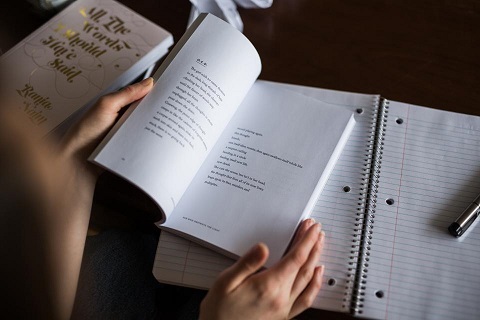am的否定形式

am的否定形式为:am not,或者又写为:ain't,但是ain't普遍认为不太规范。也可用作are not,is not,has not,will not和 have not的缩略语。一般句子变为否定句时,把否定词not加在动词be (am, is, are)的后面即可。
am的用法
am第一人称I+am (注意:“I”无论何时都要大写,不管位于句首还是句中)
例: I am twenty.
I am 还可缩写成I'm。
变否定句时,直接在am后面加not,但是am与not不能缩写。
如:I am not David. 我不是大卫。
变为一般疑问句,把am提前到句首并大写首字母。
如:Am I twenty
英语否定式有哪几种形式
(1)谓语动词为he动词的否定句:he+not.
例:He is not a teacher.他不是一名老师。
I am not studying English.我不在学习英语。
(2)谓语动词中有情态动词的否定句:情态动词+not+动词原形。
例:You should not leave.你不应该离开。
I can't do that.我不能那样做。
(3)一般动词的否定句有四种:
一般现在时:do/does+not+动词原形。
例:I do not like studying English.我不喜欢学英语。
He does not want to drink coffee.他不想喝咖啡。
一般过去时:did+not+动词原形。
例:We did not go to swim yesterday.昨天我们没去游泳。
She did not return home on time她没有按时回家。
现在/过去完成时:have/has/had+not+动词过去分词。
例:I have not eaten breakfast this morning.我今天早晨没吃早餐。
She has not finished her homework.她没有完成家庭作业。
一般将来时:will/shall+not+动词原形。
例:He will not go there.他不会去那里。
They will not go to the cinema tomorrow.他们明天不会去看电影。
《am的否定形式》拓展阅读

初中英语八大时态总结
英语语法一直都是中学英语学习的一项重点和难点,而在这其中时态无疑是初中英语最重要的语法内容,学好时态基本就拿下了语法的半壁江山。今天,帮大家总结的八种时态是大家在初中阶段必学必考的,在寒假期间复习时,不要忘了拿出来看看哦!
01
一般现在时
1. 概念:经常、反复发生的动作或行为及现在的某种状况。
2. 基本结构:①is/am/are;②do/does
否定形式:①am/is/are + not;
②此时态的谓语动词若为行为动词,则在其前加don‘t,如主语为第三人称单数,则用doesn’t,同时还原行为动词。
3. 一般疑问句:①把is/am/are动词放于句首;②用助动词do提问,如主语为第三人称单数,则用does,同时,还原行为动词。
4. 用法
1) 经常性或习惯性的动作,常与表示频度的时间状语连用。
例如:I leave home for school at 7 every morning。每天早上我七点离开家。
2) 客观真理,客观存在,科学事实。
例如:The earth moves around the sun。地球绕太阳转动。
Shanghai lies in the east of China。上海位于中国东部。
3) 表示格言或警句。
例如:Pride goes before a fall。骄者必败。
注意:此用法如果出现在宾语从句中,即使主句是过去时,从句谓语也要用一般现在时。
例如:Columbus proved that the earth is round。哥伦布证实了地球是圆的。
4) 现在时刻的状态、能力、性格、个性。
例如:I don‘t want so much。我不要那么多。
Ann writes good English but does not speak well。安英语写得不错,讲的可不行。
5) 一般现在时表示将来含义
a.下列动词come, go, arrive, leave, start, begin, return的一般现在时可以表示将来,主要用来表示在时间上已确定或安排好的事情。
例如:The train leaves at six tomorrow morning。火车明天上午六点开。
When does the bus star? It stars in ten minutes。汽车什么时候开?十分钟后。
b.在时间或条件句中。
例如:When Bill comes (不是will come), ask him to wait for me。比尔来后,让他等我。
I‘ll write to you as soon as I arrive there。我到了那里,就写信给你。
02
一般过去时
1.概念:过去某个时间里发生的动作或状态;过去习惯性、经常性的动作、行为。
2.基本结构:
①was/were;②行为动词过去式
否定形式:①was/were + not;②在行为动词前加didn‘t,同时还原行为动词。
一般疑问句:①was或were放于句首;②用助动词do的过去式did 提问,同时还原行为动词。
3.用法
1) 在确定的过去时间里所发生的动作或存在的状态。
时间状语有:yesterday, last week, an hour ago, the other day, in 1982等。
例如:Where did you go just now? 刚才你上哪儿去了?
2) 表示在过去一段时间内,经常性或习惯性的动作。
例如:When I was a child, I often played football in the street。
我是个孩子的时候,常在马路上踢足球。
Whenever the Browns went during their visit, they were given a warm welcome。
那时,布朗一家无论什么时候去,都受到热烈欢迎。
注意:used to + do:“过去常常”表示过去习惯性的动作或状态,但如今已不存在。
例如:Mother used not to be so forgetful。老妈过去没那么健忘。
Scarf used to take a walk。斯卡夫过去常常散步。
03
现在进行时
1.概念:表示现阶段或说话时正在进行的动作及行为。
2.时间状语:now, at this time, these days, etc。
3.基本结构:
am/is/are + doing
否定形式:am/is/are + not + doing。
一般疑问句:把be动词放于句首。
4.用法:
1) 表示现在(指说话人说话时)正在发生的事情。
例如:We are waiting for you。我们正在等你。
2) 习惯进行:表示长期的或重复性的动作,说话时动作未必正在进行。
例如:Mr。Green is writing another novel。他在写另一部小说。(说话时并未在写,只处于写作的状态。)
3) 表示渐变,这样的动词有:get, grow, become, turn, run, go, begin等。
例如:The leaves are turning red。叶子在变红。
It‘s getting warmer and warmer。天越来越热了。
4) 与always, constantly, forever 等词连用,表示反复发生的动作或持续存在的状态,往往带有说话人的主观色彩。例如:
You are always changing your mind。你老是改变主意。
5) 用现在进行时表示将来
下列动词come, go, arrive, leave, start, begin, return等瞬时动词的现在进行时可以表示将来。
例如:I‘m leaving tomorrow。明天我要走了。
Are you staying here till next week? 你会在这儿呆到下周吗?
04
过去进行时
1.概念:表示过去某段时间或某一时刻正在发生或进行的行为或动作。
My brother fell while he was riding his bicycle and hurt himself。
我兄弟骑车时摔了下来,受了伤。
When I got to the top of the mountain, the sun was shining。
我到达山顶时,阳光灿烂。
2.时间状语:at this time yesterday, at that time或以when引导的谓语动词是一般过去时的时间状语等。
3.基本结构:
was/were + doing
否定形式:was/were + not + doing。
一般疑问句:把was或were放于句首。
4.用法
1) 过去进行时表示过去某段时间内持续进行的动作或者事情。
We were watching TV from seven to nine last night。
昨天晚上七点到九点的时候我们在看电视。
2) 过去进行时可以表示在过去某个时间点发生的事情。
时间点可以用介词短语、副词或从句来表示。
What was she doing at nine o‘clock yesterday?
昨天晚上九点她在做什么? (介词短语表示时间点)
She was doing her homework then。
那个时候她正在写作业。(副词表示时间点)
When I saw him he was decorating his room。
当我看见他的时候他正在装饰房间。(when从句表示时间点)
3) 在复合句中,如果主要动作和背景动作都是延续的或同时发生的,那么主从句的动词都可用过去进行时。
When he was waiting for the bus, he was reading a newspaper。
他边等车边看报。(两个动作都是延续的)
He was cleaning his car while I was cooking。
他擦车时我在做饭。(两个动作同时进行)
05
一般将来时
1.概念:表示将要发生的动作或存在的状态及打算、计划或准备做某事。
2. 时间状语:tomorrow, next day(week, month, year),soon, in a few minutes, by the day after tomorrow, etc。
3.基本结构:
①am/is/are/going to + do;
②will + do。
否定形式:①am/is/are + not + going to + do
②will not(won‘t)+ do。
一般疑问句:①am/is/are放于句首;
②will提到句首。
4. will主要用于在以下三个方面:
1) 表示主观意愿的将来。
They will go to visit the factory tomorrow。
明天他们将去厂参观工厂。
I‘ll come with Wang Bing, Liu Tao and Yang Ling。
我将和王兵、刘涛、杨玲一起来。
2) 表示不以人的意志为转移的客观的将来。
Today is Saturday。Tomorrow will be Sunday。
今天是星期六。明天是(将)是星期日。
He will be thirty years old this time next year。
明年这个时候他就(将)三十岁。
3) 表示临时决定,通常用于对话中。
—Mary has been ill for a week。
玛丽病了一周了。
—Oh, I didn‘t know。I will go and see her。
噢,我不知道。我去看看她。
5. be going to主要用于一下两个方面:
1) 表示事先经过考虑、安排好打算、计划要做某事。
Dad and I are going to watch an opera this afternoon。
今天下午我和爸爸打算去看歌剧。
2) 表示根据目前某种迹象判断,某事非常有可能发生,表示推测。
Look! There come the dark clouds。It is going to rain。
瞧!乌云密集。天要下雨了。
06
过去将来时
1.概念:立足于过去某一时刻,从过去看将来,常用于宾语从句中。
2.时间状语:the next day(morning, year),the following month(week),etc。
3.基本结构:
①was/were/going to + do;
②would + do。
否定形式:①was/were/not + going to + do;②would + not + do。
一般疑问句:①was或were放于句首;②would 提到句首。
4.用法
1) “would+动词原形”常表示主观意愿的将来。例如:
He said he would come to see me。
他说他要来看我。
He told me he would go to Beijing。
他告诉我他将去北京。
2) “was/ were + going to + 动词原形”常表示按计划或安排即将发生的事。例如:
She said she was going to start off at once。
她说她将立即出发。
I was told that he was going to return home。
有人告诉我他准备回家。
此结构还可表示根据某种迹象来看,很可能或即将发生的事情。例如:
It seemed as if it was going to rain。
看来好像要下雨。
3) come, go, leave, arrive, start等瞬时动词动词可用过去进行时表示过去将来的含义。例如:
He said the train was leaving at six the next morning。
他说火车将于第二天早晨六点离开。
She told me she was coming to see me。
她告诉我她要来看我。
07
现在完成时
1.概念:过去发生或已经完成的动作对现在造成的影响或结果,或从过去已经开始,持续到现在并且有可能继续下去的动作或状态。
2.时间状语:recently, lately, since, for, in the past few years, etc。
3. 基本结构:have/has + done
否定形式:have/has + not +done。
一般疑问句:have或has。
4. since的三种用法
1) since +过去一个时间点(如具体的年、月、日期、钟点、1980, last month, half past six)。
例如:I have been here since 1989。1989起,我一直在这儿。
2) since +一段时间+ ago。
例如:I have been here since five months ago。我在这儿,已经有五个月了。
3) since +从句(一般过去时)。
例如:Great changes have taken place since you left。你走后,变化可大了。
比较since和for
since 用来说明动作起始时间,for用来说明动作延续时间长度。
例如:I have lived here for more than twenty years。我住在这儿二十多年了。
注意:并非有for 作为时间状语的句子都用现在完成时。
I worked here for more than twenty years。(我现在已不在这里工作。)
08
过去完成时
1.概念:以过去某个时间为标准,在此以前发生的动作或行为,或在过去某动作之前完成的行为,即“过去的过去”。
2. 时间状语:before, by the end of last year(term, month),etc。
3.基本结构:had + done。
否定形式:had + not + done。
一般疑问句:had放于句首。
4.用法
1) 在told, said, knew, heard, thought等动词后的宾语从句种。
例如:She said (that)she had never been to Paris。她告诉我她曾去过巴黎。
2) 在过去不同时间发生的两个动作中,发生在先,用过去完成时;发生在后,用一般过去时。
例如:When the police arrived, the thieves had run away。警察到达时,小偷们早就跑了。
3) 表示意向的动词,如hope, wish, expect, think, intend, mean,
suppose等,用过去完成时表示“原本…,未能…”。
例如:We had hoped that you would come, but you didn‘t。那时我们希望你能来,但是你没有来。
注意:had hardly… when。。。刚。。。。。。就。。。。。。。
例如:I had hardly opened the door when I he hit me。我刚打开门,他就打了我。
had no sooner…than 刚…… 就……。
例如:He had no sooner bought the car than he sold it。他刚买了这辆车,转眼又卖了。
以上就是关于am的否定形式(初中英语八大时态总结)的所有内容,希望对你有所帮助。标签: am的否定形式







